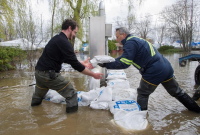Support strong Canadian climate journalism for 2025
The St. Lawrence Seaway saw cargo numbers fall sharply last year, as trade tensions and record water levels teamed up with harsh weather to hurt traffic.
The St. Lawrence Seaway Management Corp. says shipping dropped nearly seven per cent to about 38 million tonnes in 2019 — a notable dip from the 10-year high of 2018.
Seaway authority CEO Terence Bowles says trade friction with the U.S. dented shipments, but hopes the pending ratification of Canada's new free-trade pact with the U.S. and Mexico will boost numbers this year.
Heavy spring snowmelt and rains prompted record water levels on several Great Lakes, interrupting navigation on the St. Lawrence Seaway as swift, swirling currents near the Moses-Saunders Power Dam in Cornwall, Ont., slowed ship movement through the locks — the seaway's only point of water control.
Rain also drenched the country's wheat crop, delaying the harvest and decreasing grain cargo by more than 15 per cent year over year to about 12 million tonnes.
Bruce Burrows, president of the bi-national Chamber of Marine Commerce, is calling on the seaway's International Joint Commission to launch a study into water levels and their causes and to develop a "climate resiliency" plan.
This report by The Canadian Press was first published Jan. 16, 2020.





Comments